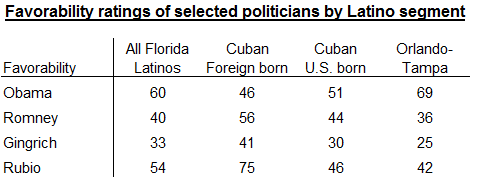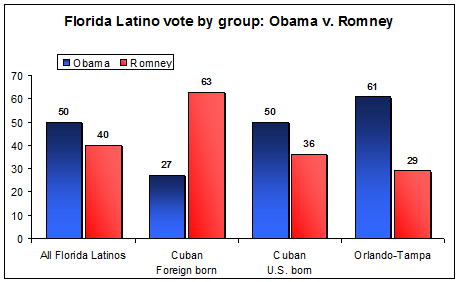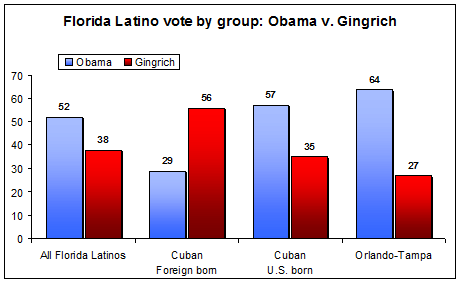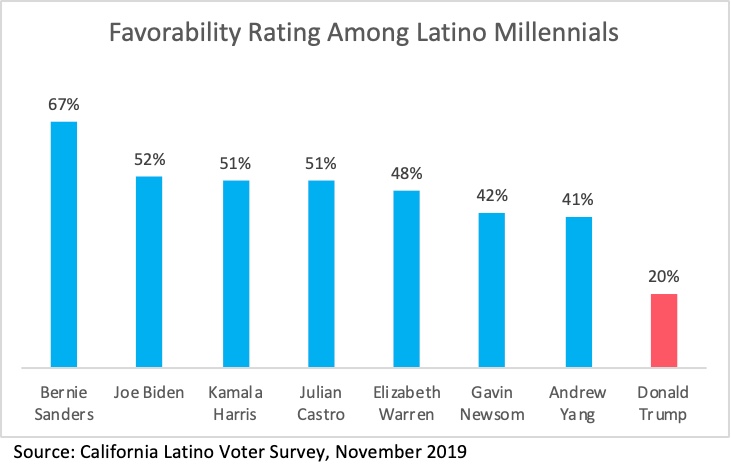With all the newfound interest in the Latino vote in Florida almost all coverage has missed an interesting and very important nuance – there is not one single Latino electorate in Florida, but rather, at least three distinct blocs. In order to best understand Latino preferences in the Sunshine state on Tuesday, and more so in November, election observers – and the candidates – would be wise to hone in on the important differences between three key segments of the Latino vote in Florida.
A few days ago, Latino Decisions released a poll in partnership with Univision News and ABC which found Romney besting Gingrich in the Republican primary, and Obama head of both Republicans in a potential match-up in November. However a closer look at the data reveals important differences within the Florida Latino electorate. Most obvious, and well known, are the differences between the South Florida, Miami-Broward Latino population which is predominantly Cuban American, and the Central Florida, Orlando-Tampa population with a large Puerto Rican. Further, within the Cuban population, important differences exist between the older more conservative immigrant generation, and the somewhat younger and much more moderate U.S. born Cuban American electorate. Readers can find full results of our Florida survey here, with banner points for Cuban, Puerto Rican, Miami, Orlando, and other differences within the state.
In this post, we summarize the key distinctions for issues and vote choice within the Florida Latino electorate. In courting and mobilizing the Latino vote in Florida Republican candidates, the President, and their surrogates can not take a one size fits all approach. Instead they should fine tune different approaches to the Latino vote in Miami versus Orlando or Tampa, and take into account different viewpoints of Cubans, Puerto Ricans, Colombians, Nicaraguans, Dominicans, and other Latinos who make up important components of the overall Florida electorate.
Candidate Favorability
Overall, we find Obama fares well in Florida with a 60 percent favorability rating, however there is considerable variation by the three Florida electorates identified above. Among Cuban immigrants, just 46% hold a favorable view of President Obama, compared to 51% among U.S. born Cubans, and 69% among Latinos in the Orlando-Tampa greater markets in Central Florida. Similarly, we see segmentation on views of Romney with 56% of foreign-born Cubans being favorable, but just 44% of U.S. born Cuban Americans, and just 36% favorable in the largely Puerto Rican Central Florida. Gingrich, who is less popular overall, still sees the same pattern by group. Finally, Senator Marco Rubio remains very popular among Cuban immigrants, but his favorability is nearly 30 points lower among U.S. born Cubans, and Latinos in Orlando and Tampa. At the same time, when asked if the selection of Rubio as a vice presidential candidate would make Latinos more likely, or less likely to vote for the GOP ticket, Rubio has overwhelming draw among foreign-born Cubans with 70% saying they would be more likely to vote Republican and only 9% saying it would make them less likely. Yet among U.S. born Cubans the advantage narrows considerably, and among those in Central Florida the Rubio bump is even smaller. Rather than widespread, it would seem his appeal is concentrated.


Different Views on the Issues
When it comes to the economy and immigration, the two most important issues to Latinos in Florida, once again three interesting groupings of results emerge. When we asked who is more to blame for the current economic problems in America, 59% of Orlando-Tampa area Latinos blame the policies of the Bush administration and 27% blame the Obama administration. Among Cubans, there is a split with a 51-27 ratio of blaming Bush-to-Obama for the poor state of the economy, while among immigrant Cubans a 28-55 Bush-to-Obama ratio emerges. When asked about how to best improve the economy, foreign born Cubans are much more likely to prefer lowering taxes (48%) than government investment in programs (33%), and U.S. born Cuban Americans are equally split with 45% favoring lower taxes and 44% favoring government investment. Among Latinos in the Orlando-Tampa metro areas just 30% say lower taxes and 58% say government stimulus.
Finally, when we look to immigration, for the first time more similarity than difference is found. Support for the DREAM Act remains high among all segments of the Florida Latino electorate with over 75% of all subgroups indicating support for earned citizenship if undocumented immigrant youth attend college or serve in the military. Likewise, when we examine comprehensive immigration reform a majority of all Latinos in Florida support an earned path to citizenship, though U.S. born Cuban Americans, and Latinos in Central Florida are somewhat more likely to support CIR.

Looking Ahead to November 2012
While differences are likely to emerge within the Latino vote during Tuesday’s Republican primary, they may not be as apparent as they will be in November. Republicans are far more likely to be comprised of Cuban immigrants, while U.S. born Cubans are fairly split between the two parties, and Puerto Ricans, found in large number in the Orlando and Tampa areas are far more likely to identify as Democrat. While such claims have been made before, it is always best to look at the actual data, to see what trends are born out.
In a general election match-up between Obama and Romney, statewide the Univision/ABC/Latino Decisions survey reported 50% for Obama and 40% for Romney. Within the three Latino electorates we identify here we find sizable differences. Foreign-born Cubans side with Obama at 27% and 63% for Romney. Their children – U.S. born Cuban Americans – give Obama 50% and Romney just 36%. More stark, in the Orlando and Tampa markets, 61% support Obama and 29% for Romney. Looking at a Gingrich nomination, the same patterns emerge. Cuban immigrants are reliable Republican votes, while U.S. born Cubans trend Democrat, and Central Florida Latinos are the most likely to support Obama over Gingrich.


The 3 Latino Electorates Within Florida
Not only during the primary phase, but again in the general, all eyes will be on Florida, and the Latino vote here will be crucial. But unlike other states with large Latino populations in the Southwest, the Latino population in Florida is the most diverse, both politically and ethnically. As candidates engage the Florida Latino electorate they need to keep in mind the unique differences between Miami and Central Florida; between Puerto Ricans and Cubans; and among Cubans, emerging differences between immigrants and U.S. born. The three groups we examine here are the largest and most distinct, but by no means are they only Latino groups in Florida. Very large numbers of Colombian, Dominican, Nicaraguan, and Mexican Latinos are spread out across Florida. While the data usually points to these other Latino groups as looking more similar to the Orlando-Tampa results presented here, additional nuances remain. Candidates and groups hoping to influence need to move away from a one-size-fits-all approach, and be sure to fine tune their outreach plans, and campaign commercials to reach different Latino audiences in Miami, Orlando, Tampa and elsewhere, and get to know the intricacies of the Latino electorate in Florida if they hope to win big in November.
Matt A. Barreto, Ph.D., is co-founder of Latino Decisions, and Associate Professor of Political Science at the University of Washington. He can be reached at [email protected]


